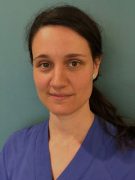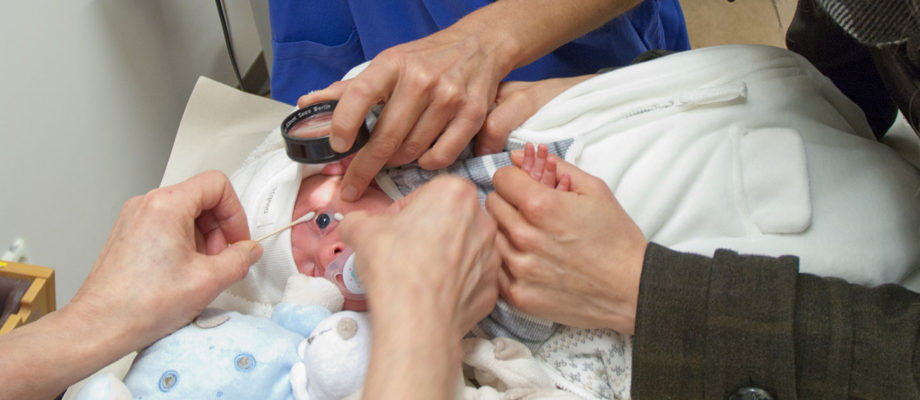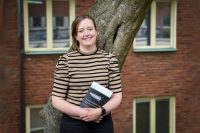GRANTS. Ann Hellström and Verena Sengpiel are heads of research for major clinical treatment studies, which have received almost SEK 20 million each from the Swedish Research Council’s call for clinical treatment research proposals. One study tests whether eye drops with cortisone can reduce the risk of eye disease that can afflict premature babies, and the other investigates whether it is safe to induce labor at home.
Verena Sengpiel, an associate professor of obstetrics and gynecology at Sahlgrenska Academy and obstetrician at Sahlgrenska University Hospital, is the main applicant for a project that will investigate whether the first phase of induced labor can take place at home.
Around the world, it is increasingly common for labor to be induced. New studies have shown the benefits of inducing labor in the forty-first week instead of waiting until the forty-second week. The national guidelines in Sweden have since been changed to offer induced labor in the forty-first week. This means that about every third birth in Sweden is initiated with induced labor.

“Some studies indicate that women who undergo labor induction prefer to return home until active labor begins, known as home induction, and that this can have benefits from a health economics perspective,” says Verena Sengpiel. “Although home induction is a clinical procedure in several countries, not enough major studies have examined whether it is as safe for mother and child as when labor is induced in the hospital.”
Swedish maternity care’s largest study

In the new study, Verena Sengpiel and colleagues will investigate whether initiating induced labor at home would be a safe alternative for mother and child. It is a massive study. A total of 8,890 women will be included, with half randomly selected for labor induction at home and half in the hospital.
“This is the largest study we have done in Swedish maternity care. I think it is great that almost all women’s clinics will participate and that our research collaboration within the framework of our SNAKS network for national clinical studies in obstetrics and gynecology (www.snaks.se) has now come so far that we can conduct studies of this quality and scope,” says Sengpiel.
Protracted inductions
Labor is induced either through medication or a small balloon, which slowly softens and shortens the part of the cervix within the vagina. It can take several days after induction before active labor begins, and for that reason these women spend extended time in the hospital before onset. It is common for women to experience a birth that needs to be induced as protracted and difficult.
For the study, pregnant women who are expected to have a low risk of complications will be randomly selected to either return home after induction has begun at the hospital or to remain in the hospital.
“It is especially gratifying to be studying a subject that can be a real win-win, with increased satisfaction for both patient and partner, better utilization of resources and possibly also a better clinical outcome,” says Sengpiel.
Good potential for premature babies
Ann Hellström is a professor of pediatric ophthalmology at the Institute of Neuroscience and Physiology and chief physician at the Pediatric Ophthalmology Section, Queen Silvia Children’s Hospital. Her goal is to provide children born very prematurely with the best possible potential to develop as normally as possible. Her special expertise lies in retinopathy of prematurity (ROP), an eye disease caused by blood vessels in the retina not developing properly. This can lead to visual impairment and, in the worst case, blindness in the premature baby.
Avoiding destructive laser treatment
In general, ROP that requires treatment occurs at an age corresponding to more than 34 weeks after the mother’s last menstruation–in other words, often several months after premature birth. In Sweden all children born before 30 full weeks of pregnancy are screened for ROP, and about 40 children a year end up needing treatment. The children then receive either a laser treatment, which destroys the peripheral retina, or injections of anti-VEGF into the eye, a pharmaceutical that counteracts uncontrolled pathological blood vessel growth.
“In Lund, several children with ROP have received dexamthasone, a synthetic cortisone, as eye drops during the past year to reduce inflammation before they receive laser treatment. We have then observed that laser treatment could be avoided in most cases,” says Ann Hellström.
Randomized multicenter study
The Swedish Research Council is now providing SEK 19 million to implement a multicenter study known as “DROPROP” in six regions in Sweden. For the study, 100 children diagnosed with incipient pathological blood vessels in the retina or retinal bleeding will be treated with eye drops. The children will be randomly selected to either be treated with dexamethasone eye drops or be included in a control group, where they receive a physiological saline solution instead.
The aim is to investigate whether eye drops with dexamethasone can reduce the proportion of children who need to be anesthetized and receive laser or anti-VEGF treatment.
“If the drop treatment is successful, this will greatly benefit this fragile and severely afflicted group of children who would avoid being anesthetized one or more times, which runs the risk of having a negative effect on their brain development. Treatment with eye drops would also be a great advantage in parts of the world where access to other treatment options is limited and many children become blind, perhaps needlessly,” says Hellström.
The project will also investigate biomarkers in blood left over from clinical sampling to investigate the relationship between these and ROP development and treatment results.
BY: ELIN LINDSTRÖM











